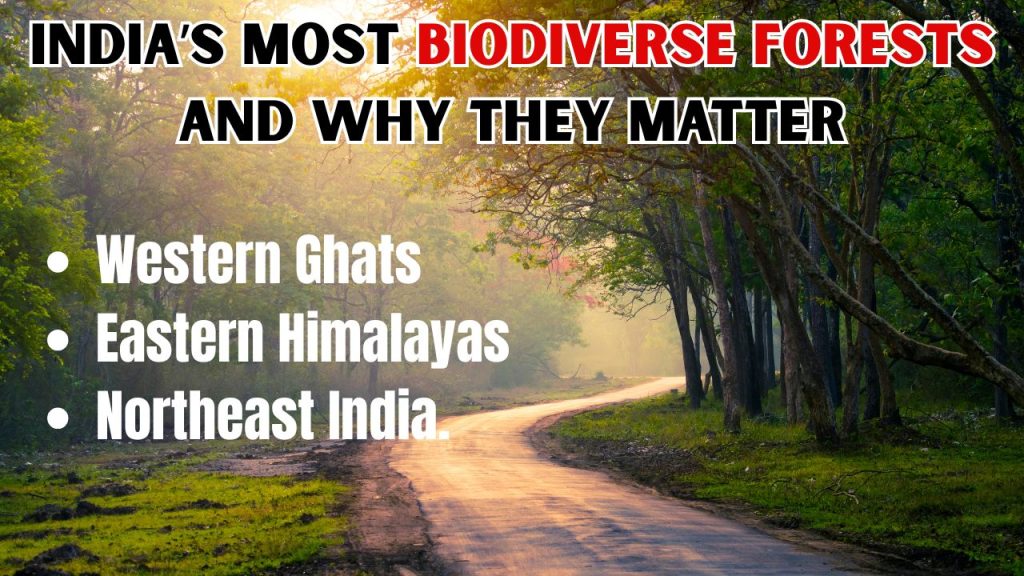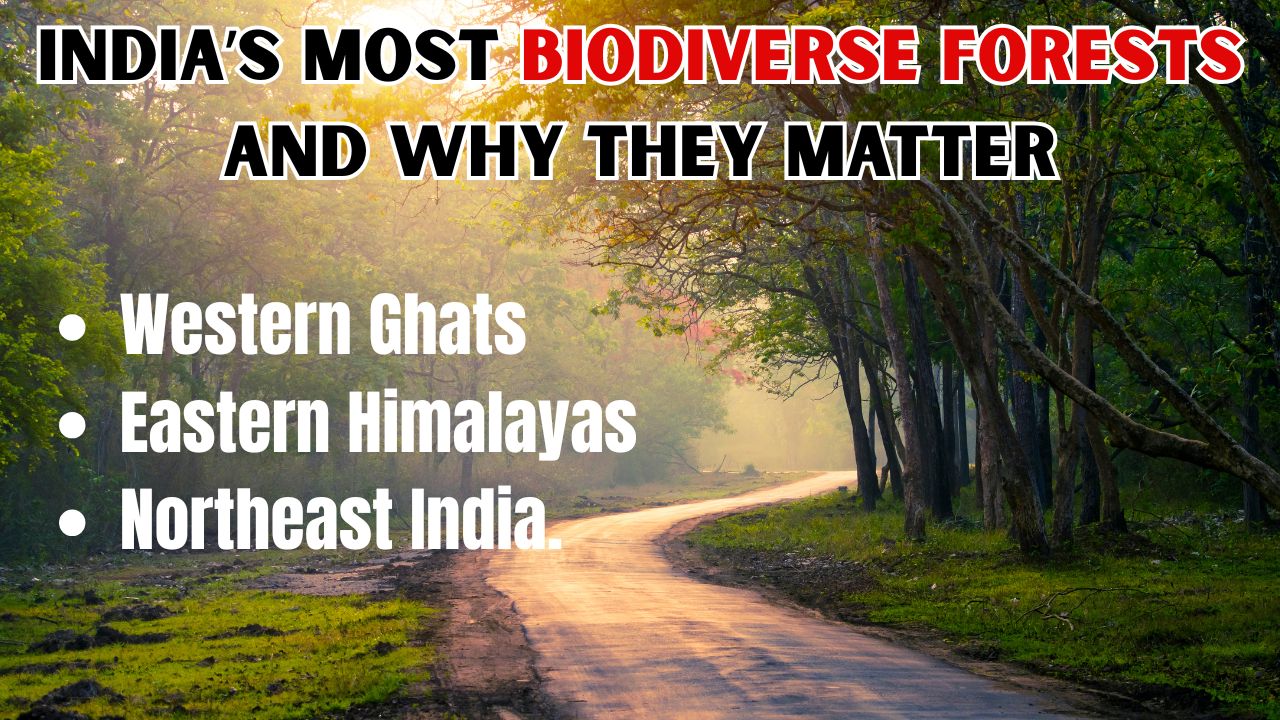
India’s forests are more than just green expanses; they are vibrant, living ecosystems brimming with life, color, and stories. Spanning from the steamy lowland jungles of the Northeast to the mist-cloaked peaks of the Western Ghats and the alpine stretches of the Eastern Himalayas, India’s biodiversity is among the richest in the world. These forests are not only natural treasures but also critical guardians of ecological balance, climate stability, and cultural heritage.
Let’s venture deep into three of India’s most biodiverse forest regions—the Western Ghats, the Eastern Himalayas, and Northeast India—and uncover why these green realms are vital for the country and the planet.
1. The Western Ghats: Ancient Green Giants
Stretching over 1,600 kilometers along the western coast of India, the Western Ghats are a UNESCO World Heritage Site and one of the world’s eight “hottest hotspots” of biodiversity. These mountains, older than the Himalayas, are cloaked in lush tropical rainforests, montane forests, and shola grasslands. Their staggering biodiversity includes over 7,400 species of plants and animals, many of which are endemic—found nowhere else on Earth.
Some iconic species call this region home: the lion-tailed macaque with its silver mane, the Malabar civet, the Nilgiri tahr, and the elusive tiger that prowls the denser forests. It is also a birder’s paradise, with species like the Great Indian Hornbill and the Nilgiri Flycatcher gracing its canopy.
The Western Ghats are not just about wildlife. They are the lifeline for millions, as they intercept the monsoon winds and feed the major river systems like the Godavari, Krishna, and Kaveri. Their forests act as natural water reservoirs, prevent soil erosion, and regulate the climate. Sacred groves nestled within the Ghats reflect the indigenous communities’ age-old reverence for nature, blending conservation with culture in a seamless fabric.
But the Western Ghats are under siege. Expanding plantations, mining, and unregulated development are fragmenting habitats and endangering the species that dwell within. Conservation efforts—like community-based eco-tourism and sustainable agroforestry—are crucial to preserving this emerald stretch for generations to come.
2. Eastern Himalayas: The Snow-Clad Biodiversity Corridor
While the Himalayas are often romanticized for their snow-capped peaks and spiritual pull, their eastern stretches are ecological powerhouses in their own right. The Eastern Himalayas—covering parts of Sikkim, North Bengal, Bhutan, and Arunachal Pradesh—harbor a unique mix of tropical and alpine ecosystems.
Here, in the lap of high mountains and deep valleys, thrive red pandas, snow leopards, Himalayan monals, takins, and a rich variety of orchids, rhododendrons, and medicinal plants. This region alone is home to more than 10,000 plant species and over 750 bird species. It’s not unusual to stumble upon entirely new species even today—such is the unexplored richness of these wild terrains.
One of the crown jewels of this region is the Khangchendzonga National Park in Sikkim, a UNESCO World Heritage Site that seamlessly integrates biodiversity with spiritual traditions. Local communities consider the landscape sacred and have historically protected it through indigenous conservation practices.
The Eastern Himalayas also act as a vital climate buffer. Their glaciers feed major rivers like the Brahmaputra and the Teesta, and their forests play a significant role in carbon sequestration. Yet, climate change poses a direct threat—melting glaciers, erratic weather, and shifting species ranges are already evident.
Sustainable tourism, community-led conservation, and transboundary cooperation between India, Bhutan, and Nepal are essential to protecting this fragile but immensely important ecosystem.
3. Northeast India: The Rainforest Realm
Tucked away in the far east of the country, Northeast India is a wonderland of biodiversity, culture, and mystery. The states of Assam, Meghalaya, Manipur, Mizoram, Nagaland, Tripura, and Arunachal Pradesh are home to dense rainforests, bamboo groves, wetlands, and cloud forests that teem with life.
What makes this region truly special is its position at the confluence of the Indo-Malayan, Indo-Chinese, and Himalayan biodiversity hotspots. The result? An explosion of life. From hoolock gibbons swinging in the canopy to pygmy hogs and golden langurs in the undergrowth, the variety is breathtaking. The region also hosts rare orchids, medicinal plants, and some of the world’s largest butterflies.
Kaziranga National Park in Assam, a World Heritage Site, is renowned for its one-horned rhinoceroses, while Namdapha National Park in Arunachal Pradesh is one of the few places where four big cats—tiger, leopard, snow leopard, and clouded leopard—coexist.
Importantly, the forests of the Northeast are intertwined with tribal cultures that have safeguarded biodiversity for centuries through sacred groves and sustainable practices. However, increasing pressure from deforestation, jhum (slash-and-burn) agriculture, infrastructure development, and poaching threatens the balance.
Empowering indigenous communities, enforcing strict anti-poaching laws, and promoting ecotourism are some of the ways to nurture this treasure trove of biodiversity.
Why These Forests Matter
India’s biodiversity-rich forests are more than scenic getaways or wildlife habitats—they are life support systems. They regulate climate, purify air and water, support pollination, protect soil, and sequester carbon. In the age of climate change, these forests act as vital carbon sinks and buffers against extreme weather.
Moreover, they hold deep cultural and spiritual significance for countless communities, acting as custodians of ancient wisdom and sustainable living. Traditional ecological knowledge passed down through generations offers insights into living in harmony with nature—something modern society is only beginning to rediscover.
Preserving biodiversity is not a luxury; it’s a necessity. The loss of even a single species can trigger cascading effects on ecosystems. The interconnectedness of life means that human well-being, food security, and even economic stability are inextricably linked to healthy, functioning forests.
The Road Ahead: Conservation and Coexistence
Protecting these forests is a monumental task—but not an impossible one. It requires a multi-pronged approach:
- Community Involvement: Forest-dwelling and indigenous communities must be at the forefront of conservation. Their knowledge and stewardship are invaluable.
- Policy and Enforcement: Stronger implementation of environmental laws, curbing illegal logging and mining, and regulating tourism are essential.
- Scientific Research: Continued ecological research and biodiversity mapping help guide better conservation strategies.
- Awareness and Education: Building a culture of respect and curiosity toward nature, especially among the youth, is critical for long-term conservation.
India’s forests are not just national treasures—they are global assets. As the country walks the tightrope between development and conservation, safeguarding its wild frontiers must remain a priority. Because when we protect biodiversity, we are ultimately protecting ourselves.
